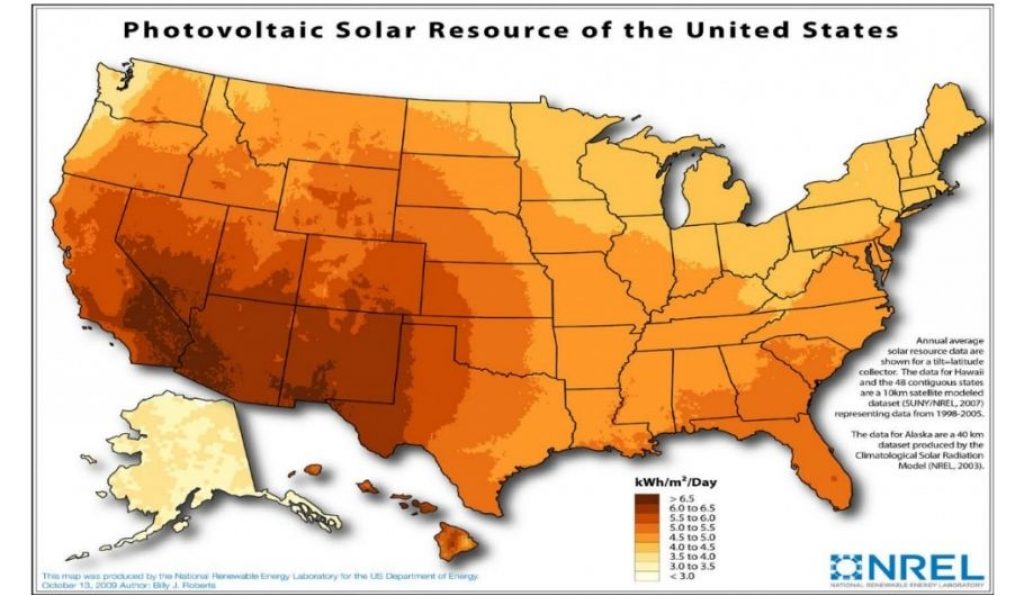Solar panels have become increasingly popular thanks to their numerous benefits. Aside from the environmental advantages, the financial gains associated with solar panels depend on the amount of energy they can produce — the “solar panel output.” A working example is available here for California.
Building a solar array requires multiple panels. As such, the fundamental unit is the panel itself. Therefore, a solar panel’s power and energy output are critical to the overall array’s output.
In this article, you’ll learn about:
- solar panel power ratings
- solar panel energy output calculations
- how solar panel energy output varies with location and time
- how solar panel output varies throughout the USA
Table of Contents
What Do Power And Energy Mean?
Firstly, let’s clarify our terms. The terms “power” and “energy” are everyday words, but they have a special meaning regarding electricity.
Power
Power is what we see written on the side of household appliances. It’s measured (both generation and consumption) in “watts.”

Phone chargers (20 Watts), Kettles (3,000 Watts), and toasters (1,000 Watts) — these are all power ratings.
Energy
Energy is just power used over a period of time — an appliance that uses a lot of energy in a short amount of time is powerful, and appliances vary in their efficiency.
Example
Say, an electric kettle has a power rating of 3,000 watts. If the kettle takes 15 minutes to boil water, it has used 3,000 watts for 1/4 of an hour, or 750 watt-hours of electricity (3,000 x 15 / 60 = 750). The energy consumed is, therefore, 750 watt-hours.
The term “watt-hour” may seem familiar to you, and it’s likely because you’ve seen the term “kilowatt-hour” on your monthly electricity bill. One kilowatt-hour is simply 1,000 watt-hours.
What Is A Solar Panel Power Rating?
This principle of energy and power doesn’t just describe appliances that consume electricity. It also applies to products that produce energy, such as solar panels. As such, a solar panel’s power rating is also measured in watts.
Since sunlight is the “fuel” of solar panels, the power output of a solar panel changes as the ambient sunlight falling on it varies throughout the day.
The solar industry agreed upon standard ambient conditions for testing their panels to simplify things for the consumer. Looking at the datasheets of two different solar panels, you can compare their power ratings fairly quickly. This is true regardless of the panel design and construction.
The standard conditions for solar panel testing are 1,000 W/m2 of irradiance (“strength” of sunlight) and an air temperature of 25C.
Solar panels typically have a 30-year power warranty. The warranty gives you rights as a customer to claim back money or a repair or replacement if the panel is faulty.
What Is Solar Panel Energy Output?
The energy output of a panel is simply how much electrical energy your panel has produced over a given length of time — for example, one hour, one day, or a full year. Like the kettle example, a panel’s energy is measured in kilowatt-hours or watt-hours.
When comparing energy output from different panels, the output data must be for the same period of time, i.e., 24 hours or 1 week.
How To Calculate Solar Panel Energy Output
A solar panel, much like a garden, is sensitive to the changing environment throughout the year. Therefore, to calculate the energy output of a solar panel over a year, you need to consider the following factors:
- Panel Compass Orientation: i.e., is the panel facing north, east, west, or south? In the northern hemisphere, panels pointed south get more sun than panels pointed north.
- Panel Tilt: the tilt of a panel relative to the ground or roof. This affects how much sun a panel will receive.
- Shading: shading will reduce the output of the shaded panels. Trees, buildings, or other features that shade the panels will reduce annual energy output.
- Ambient Solar: energy available over the year at that location —sunny places are better for solar panel output!
- Ambient Conditions: air temperature and the ground surface around the solar array affect the array’s output.
- Solar Panel: the panel’s design and building materials affect its response to ambient temperature and its efficiency in converting sunlight to electricity.
The combined effect of these factors is calculated using complicated math. Fortunately for you, we have an online calculator that can assist with the grunt work!
Peak Sun Hour Method
An alternative method is the Peak Sun Hour method, in which you take the Peak Sun Hours (“PSH”) for a location and multiply your findings by your panel’s peak power output. The result is a quick and straightforward way of estimating the average energy output of a panel in your location.
To calculate the energy output of a panel, you need to look up the peak sun hours for the location and multiply the data by the power rating of the solar panel.
The basic equation is:
Energy (in kWh) = PSH (hours) x Solar Panel Power Output (in kW)
Solar Panel Output Vs. Time Of Day
Solar panel output varies by the strength (or power) of sunlight. This means that your solar panel’s power output will vary through the day, as the strength of the sun changes from sunrise (weak) to noon (strong) and eventually to sunset (weak again).
However, some setups allow solar panels to function at night.
Solar Panel Output Winter Vs. Summer
Summer means both longer days and stronger sunlight.
This tends to vary significantly with location. A solar panel close to the equator (say Puerto Rico) will not differ much in output between winter and summer, whereas a solar panel close to the North Pole will produce a lot in summer (since summer days are longer) and a lot less in winter.
In most parts of the USA, a solar panel’s summer output to winter output is around 1 to 3, depending on the location.
5 Examples Of Solar Panel Energy Output Per Day

Source: NREL
As indicated in the above image, the energy output of a solar panel varies significantly with location.
To illustrate the difference that location makes, let’s look at five locations around the USA. In each location, we have calculated the energy output results for a single 400W (or 0.4 kW) solar panel of about 6.5 ft² in area, and we look up the peak sun hours for the location.
The basic equation is:
Energy (in kWh) = PSH (hours) x Panel Peak Power Output (in kW)
This calculation will estimate the solar panel’s average day’s energy output in that location.
To calculate this across a year, you simply multiply by 365.
Portland, Oregon
- Peak Sun Hours = 3.6
- Total energy output for one day = 3.6 x 0.4 = 1.44 kWh
- Total energy output for one year = 3.6 x 0.4 x 365 = 525.6 kWh
Utah
- Peak Sun Hours = 5.4
- Total energy output for one day = 5.4 x 0.4 = 2.16 kWh
- Total energy output for one year = 5.4 x 0.4 x 365 = 788.4 kWh
Maine
- Peak Sun Hours = 3.6
- Total energy output for one day = 3.6 x 0.4 = 1.44 kWh
- Total energy output for one year = 3.6 x 0.4 x 365 = 525.6 kWh
Florida
- Peak Sun Hours = 4.9
- Total energy output for one day = 4.9 x 0.4 = 1.96 kWh
- Total energy output for one year = 3.6 x 0.4 x 365 = 715.4 kWh
Georgia
- Peak Sun Hours = 4.6 kWh/m²/day
- Total energy output for one day = 4.6 x 0.4 = 1.84 kWh
- Total energy output for one year = 4.6 x 0.4 x 365 = 671.6 kWh
Additional Info
States closer to the equator (Hawaii, Florida) have a higher annual output and less variation from summer to winter. Likewise, states further away from the equator (Oregon, Maine) have a lower yearly output and greater seasonal variation.
Final Thoughts
Solar panels vary in power output and have a rated power output in watts.
A panel’s actual power and energy output varies with location, time of day, and time of year.
Online tools can calculate the output of your solar array, and guides can assist you with the design and installation of your array.
Should you have further questions or opinions on the topic, please share your thoughts with us on our community page!

